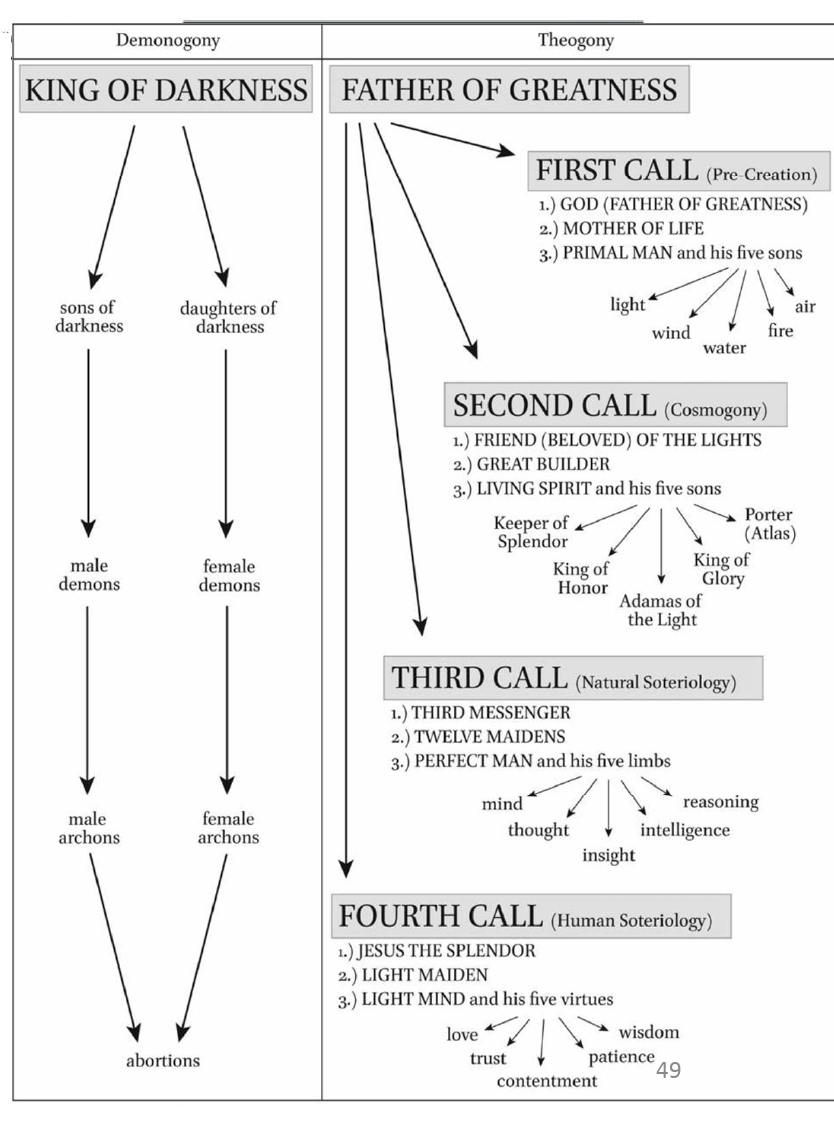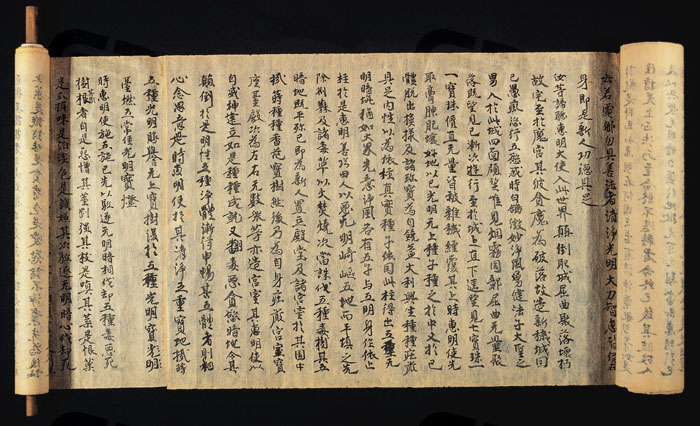Manichaeism
The world religion founded by Mani (216-276 CE) and known to history as Manichaeism has its roots in various earlier religions, borrowing elements from Zoroastrianism (another Persian religion), Christianity, and Buddhism. Mani had a desire to see his religion reach the ends of the earth. This desire was fulfilled, and until the late Middle Ages, Manichaeism remained a world religion, stretching from China to Western Europe. Unfortunately, it is now practically extinct.
The religion began when its founder experienced a series of visions, in which the Holy Spirit supposedly appeared to him, ordering him to preach the revelation of Light to the ends of the earth. Mani came to view himself as the last in a series of great prophets including Buddha, Zoroaster, and Jesus. His highly complex myth of the origin of the cosmos and of humankind drew on various elements culled from these several traditions and teachings. However, he viewed this wholly creative product as a revelation from the divinity itself. It is for this reason that Mani’s followers revered him as the redeemer and holy teacher of humankind.
Below is a map showing the spread of Manichaeism to Europe, North Africa, and China during early years of the religion:

Mani was an Iranian born in the Parthian Empire. Manichaean writings indicate that Mani received revelations when he was 12 and again when he was 24. From these revelations he believed that the teachings of Buddha, Zoroaster, and Jesus were incomplete, and that his revelations were for the entire world, calling his teachings the "Religion of Light". He began preaching in early age. Mani composed seven works, six of which were written in the Syriac language. The seventh, the Shabuhragan, was written by Mani in Middle Persian and presented by him to Shapur I of the Sassanian Empire. Although there is no proof Shapur I was a Manichaean, he tolerated the spread of Manichaeism and refrained from persecuting it within his empire's boundaries. Mani also invented a unique version of the Syriac script known as the Manichaean alphabet, which was used in many Manichaean works written within the Sassanian Empire and the Uyghur Khaganate.
Below is a Manichaeism painting showing the four prophets (from left to right): Mani, Zoroaster, Buddha and Jesus:

The Manichaean cosmology began with two oppose principles, as in Zoroastrianism: the God of Light, and the Ruler of Darkness. This Darkness, being of a chaotic nature, assails the “Kingdom of Light” in an attempt to overthrow or perhaps assimilate it. The “King of the Paradise of Light,” then, goes on the defensive, as it were, and brings forth Wisdom, who in her turn gives birth to the Primal Man, also called Ohrmazd (or Ahura-Mazda). This Primal Man possesses a pentadic soul, consisting of fire, water, wind, light, and ether. Armored with this soul, the Primal Man descends into the Realm of Darkness to battle with its Ruler. Surprisingly, the Primal Man is defeated, and his soul scattered throughout the Realm of Darkness. However, the Manichaeans understood this as a plan on the part of the Ruler of Light to sow the seeds of resistance within the Darkness, making possible the eventual overthrow of the chaotic realm. To this end, a second “Living Spirit” is brought forth, who was also called Mithra. This being, and his partner, “Light-Adamas,” set in motion the history of salvation by putting forth the “call” within the realm of darkness, which recalls the scattered particles of light (from the vanquished soul of Ohrmazd). These scattered particles “answer” Mithra, and the result is the formation of the heavens and earth, the stars and planets, and finally, the establishment of the twelve signs of the zodiac and the ordered revolution of the cosmic sphere, through which, by a gradual process, the scattered particles of light will eventually be returned to the Realm of Light. The Manichaeans believed that these particles ascend to the moon, and that when the moon is full, it empties these particles into the sun, from whence they ascend to the “new Aeon,” also identified with Mithra, the “Living Spirit”. This process will continue throughout the ages of the world, until all the particles eventually reach their proper home and the salvation of the godhead is complete.
Below are (1) a painting around the 12th century that depict this complicated system of the universe and (2) present-day illustration of the system:


Unlike the founders of most religions before his time, Mani from the start knew that his mission was to bring his religion to all parts of the world. He developed methods for this purposes. This is what he wrote about his works: "I have written them [i.e. the teachings] in books and illustrated them with colors. Let the one who hears about them verbally also see them in visual form, and the one who is unable to learn them from words, learn them from pictures.” (Manichaean quotation in Ephrem's "Prose Refutations"). He allowed his followers to adapt the religion to the cultures of the areas of mission and he also asked his followers to translate his works to as many languages as possible. Two examples are provided. Below is a painting of Akshobhya, a Buddha located in the east of Diamond Realm in Buddhism tradition, with the Cross of Light, a symbol of Manichaeism.

Below is a fragment of a Manichaeism script in Chinese:

Below is a map showing the spread of Manichaeism to 17th century:

Manichaeans were persecuted off and on throughout the years. Manichaeism was repressed by the Sassanian Empire starting from 291 CE. In 296 CE, the Roman emperor Diocletian decreed all the Manichaean leaders to be burnt alive along with the Manichaean scriptures and many Manichaeans in Europe and North Africa were killed. Manichaeans also suffered persecution under the Abbasid Caliphate of Baghdad. In 780 CE, the third Abbasid Caliph, al-Mahdi, started a campaign of inquisition against those who were "dualist heretics" or "Manichaeans".
China is one of the last places to persecute Manichaeans. In 732 CE, Emperor Xuanzong of Tang banned any Chinese from converting to the religion, saying it was a heretic religion that was confusing people by claiming to be Buddhism. However, foreigners who followed the religion were allowed to practice it without punishment because, at that time, Manichaeism was the state religion of the Uyghur Khaganate and the Khaganate was an ally of Tang with many Uyghurs in China. After the fall of the Uyghur Khaganate in 840 CE, which was the chief patron of Manichaeism in China, all Manichaean temples in China except the ones in the capital and Taiyuan were closed down and never reopened. Even those that were allowed to remain open were soon closed.
Although Manichaeism was officially banned, a small number of followers continued the religion in secret. Below is a picture of a Manichaean temple that still exists in Fujian, China. In it is a statue of Mani disguised as a Buddha.


A book and two papers are provided if you are interested to learn more about the religion:
A 2013 paper titled Contextualized Studies on the History of Manichaean Art across the Asian Continent;

A 1932 book titled Researches in Manichaeism;

A pre-1935 paper titled The Religion of the Manichees.
